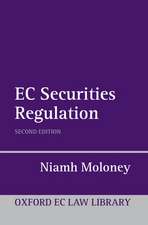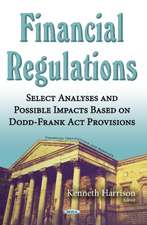The Age of ESMA: Governing EU Financial Markets
Autor Niamh Moloneyen Limba Engleză Paperback – 24 feb 2021
| Toate formatele și edițiile | Preț | Express |
|---|---|---|
| Paperback (1) | 356.50 lei 6-8 săpt. | |
| Bloomsbury Publishing – 24 feb 2021 | 356.50 lei 6-8 săpt. | |
| Hardback (1) | 601.29 lei 6-8 săpt. | |
| Bloomsbury Publishing – 28 noi 2018 | 601.29 lei 6-8 săpt. |
Preț: 356.50 lei
Preț vechi: 434.88 lei
-18% Nou
Puncte Express: 535
Preț estimativ în valută:
68.22€ • 71.08$ • 56.48£
68.22€ • 71.08$ • 56.48£
Carte tipărită la comandă
Livrare economică 03-17 aprilie
Preluare comenzi: 021 569.72.76
Specificații
ISBN-13: 9781509944330
ISBN-10: 1509944338
Pagini: 392
Dimensiuni: 156 x 234 mm
Greutate: 0.55 kg
Editura: Bloomsbury Publishing
Colecția Hart Publishing
Locul publicării:London, United Kingdom
ISBN-10: 1509944338
Pagini: 392
Dimensiuni: 156 x 234 mm
Greutate: 0.55 kg
Editura: Bloomsbury Publishing
Colecția Hart Publishing
Locul publicării:London, United Kingdom
Caracteristici
Examines ESMA's role as a pivotal actor in the development of EU financial market governance
Notă biografică
Niamh Moloney is Professor of Financial Markets Law at the London School of Economics and Political Science and a Fellow of the British Academy.
Cuprins
1. Introducing ESMA I. Introduction: Examining ESMA through an Institutional Lens II. Characterising ESMA: ESMA's Setting and its Role III. Contextualising ESMA IV. Technocratic Influence, Effectiveness, and Legitimacy V. Roadmap 2. ESMA's Governance I. Assessing ESMA and its Governance Arrangements II. Examining ESMA's Governance Arrangements III. Contextualising ESMA's Governance Arrangements: Influence, Effectiveness, and Legitimacy IV. ESMA's Institutional Design V. ESMA's External Governance Arrangements VI. ESMA's Funding Arrangements VII. Conclusion 3. ESMA and Regulatory Governance I. Assessing ESMA and the Regulatory Governance Setting II. Examining ESMA's Role in Regulatory Governance III. Contextualising ESMA's Role: Influence, Effectiveness, and Legitimacy IV. Building the Single Rule-book: ESMA as Architect of EU Administrative Financial Market Regulation V. Building the Soft Law Rule-book: ESMA as the Designer and Custodian of EU Financial Market Soft Law VI. The Legislative Process: Shaping Regulatory Governance from the Bottom Up VII. Conclusion 4. ESMA and Supervisory Convergence I. Assessing ESMA and the Supervisory Convergence Setting II. Examining ESMA's Role in Supervisory Convergence III. Contextualising ESMA's Role: Influence, Effectiveness, and Legitimacy IV. Supervisory Convergence in Practice V. Conclusion 5. ESMA and Direct Supervision/Market Intervention I. Assessing ESMA and the Direct Supervision/Market Intervention Setting II. Examining ESMA's Role as a Direct Supervisor III. Contextualising ESMA's Role: Influence, Effectiveness, and Legitimacy IV. Direct Supervision in Practice: Rating Agencies and Trade Repositories V. NCA-Oriented Supervision: Breach of EU Law, Binding Mediation, and Emergency Conditions VI. Exceptional Intervention: Short Selling, Product/Services Intervention, and Intervention in the CommodityDerivatives Market VII. Th e 2017/2018 Reform Waypoint (1): CCP Supervision and the 'European Supervisory Mechanism' VIII. Th e 2017/2018 Reform Waypoint (2): Th e 2017 ESA Proposal IX. And the Direction of Travel Continues: Th e 2018 Crowdfunding ProposalX. Conclusion 6. ESMA as a Network Actor I. ESMA as a Network Actor II. ESMA and the EU Financial Governance Network III. ESMA and the International Financial Market Governance Network IV. Conclusion
Recenzii
For academics and practitioners alike, if one wishes to gain a better understanding of how ESMA operates, there is no way around reading this highly commendable work.
The Age of ESMA is intended to ask how ESMA has come to occupy a central position in EU financial market governance and the ramifications of its expanding influence ... This ambitious target is fully met and this book, to my mind, works as the much needed and most comprehensive review of the first years of operation of ESMA, up to its recently adopted reform in Spring 2019.
The Age of ESMA is an excellent piece of research: it is replete with facts, ambitious in identifying the key questions and cautious in both its answers and in drawing lessons for the future therefrom. Anyone with an interest in understanding how centralised (both on and off the books) EU financial markets regulation is should read it.
The Age of ESMA is intended to ask how ESMA has come to occupy a central position in EU financial market governance and the ramifications of its expanding influence ... This ambitious target is fully met and this book, to my mind, works as the much needed and most comprehensive review of the first years of operation of ESMA, up to its recently adopted reform in Spring 2019.
The Age of ESMA is an excellent piece of research: it is replete with facts, ambitious in identifying the key questions and cautious in both its answers and in drawing lessons for the future therefrom. Anyone with an interest in understanding how centralised (both on and off the books) EU financial markets regulation is should read it.







